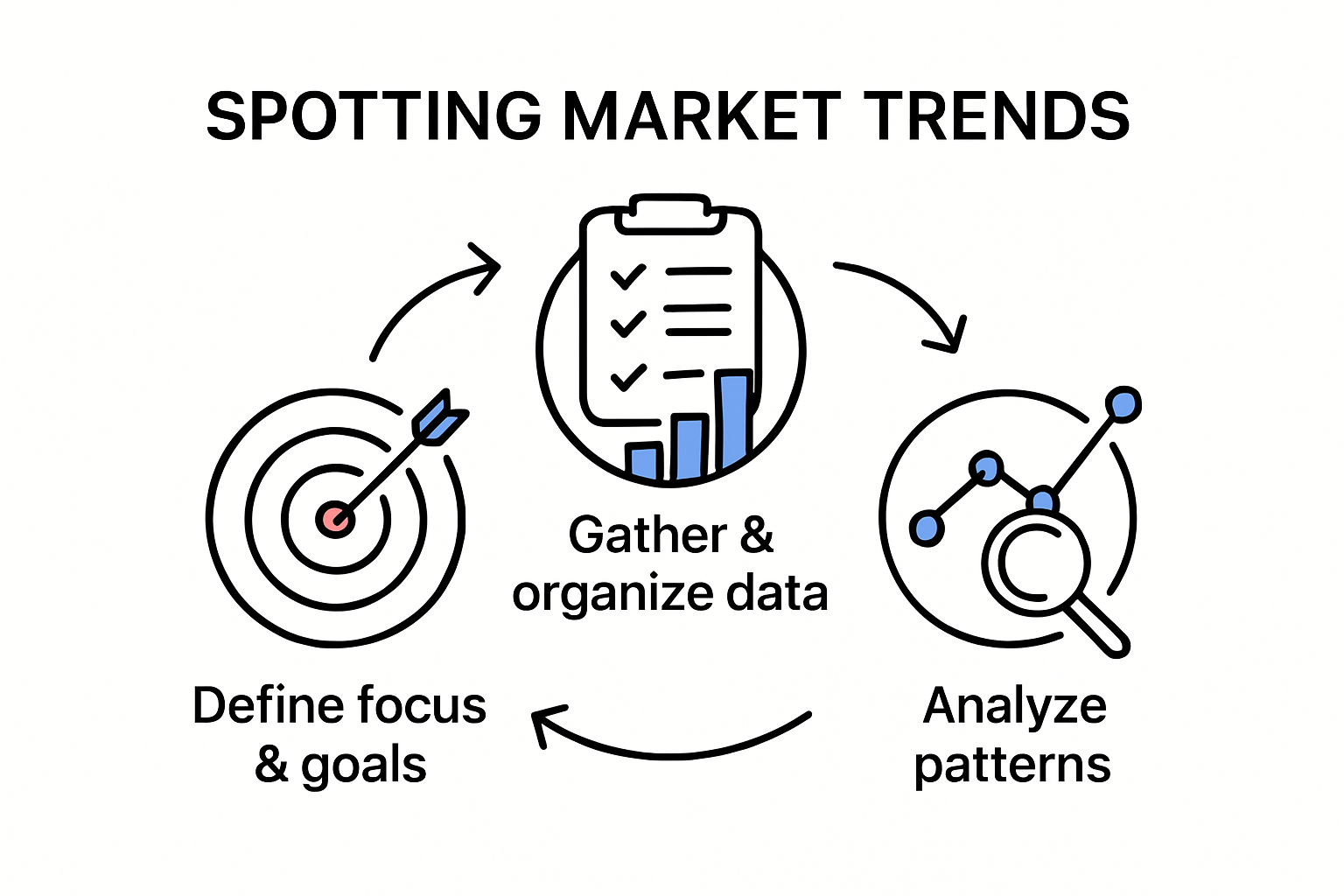Spotting profitable market trends can feel like chasing shadows in a crowded room. You might expect that endless piles of data and complex forecasts hold the answer. But according to the US Small Business Administration, true trend detection relies on having precise goals and a clear research framework right from the start. This first step makes the difference between insightful discoveries and just more noise.
Table of Contents
- Step 1: Define Your Market Focus And Goals
- Step 2: Gather Relevant Market Data And Resources
- Step 3: Analyze Historical Data And Patterns
- Step 4: Identify Current Market Sentiment And Indicators
- Step 5: Monitor Ongoing Trends And Adjust Strategies
- Step 6: Review And Validate Your Findings Regularly
Quick Summary
| Key Point | Explanation |
|---|---|
| 1. Define market focus clearly | Assess your interests and set targeted objectives for research. Identifying specific market segments will guide your trend analysis effectively. |
| 2. Gather high-quality data | Collect information from credible sources like government reports and research journals. Use a systematic approach to ensure relevance and reliability. |
| 3. Analyze historical patterns | Organize past market data to identify trends and cyclical behaviors. Look for consistent patterns that may indicate future movements. |
| 4. Monitor market sentiment actively | Use diverse sentiment indicators to gauge investor emotions and attitudes. This can predict potential market shifts and trend changes. |
| 5. Regularly validate your findings | Create a solid validation framework to scrutinize your research. Cross-reference sources and challenge assumptions for reliable market insights. |
Step 1: Define Your Market Focus and Goals
Successfully spotting market trends begins with crystal-clear strategic clarity. Before diving into complex analysis techniques, you must establish a precise understanding of your market investigation objectives and the specific landscape you intend to explore.
Defining your market focus requires a methodical approach that combines self-awareness with strategic thinking. Start by conducting an honest assessment of your current knowledge, investment interests, and financial goals. Are you investigating technology sector trends, exploring emerging markets, or seeking opportunities in traditional industries? Your specific focus will determine the depth and direction of your market trend research.
Key Preliminary Questions to Address:
- What specific market segments interest you most?
- What is your risk tolerance for potential investments?
- What financial resources can you allocate to trend research?
Next, establish concrete, measurable goals that will guide your market trend investigation. According to the U.S. Small Business Administration, effective market research hinges on understanding precise demographic information and economic indicators. Your goals might include identifying potential investment opportunities, understanding sector-specific growth patterns, or developing a comprehensive market intelligence framework.
Consider creating a structured framework that outlines your research objectives, preferred analytical methods, and expected outcomes. This approach transforms market trend spotting from a vague concept into a systematic process. Successful trend identification requires discipline, consistent methodology, and a willingness to adapt your approach based on emerging insights.

Remember that defining your market focus is not about pursuing every possible trend, but about developing a targeted, intentional strategy that aligns with your unique financial objectives and risk profile. By establishing clear parameters from the outset, you dramatically increase your chances of extracting meaningful, actionable intelligence from your market trend research.
Step 2: Gather Relevant Market Data and Resources
After defining your market focus, the next critical phase in spotting market trends involves systematic and strategic data collection. This step transforms your general objectives into actionable intelligence by assembling a comprehensive information portfolio that will fuel your trend analysis.
Data gathering requires a multifaceted approach that combines digital research tools, authoritative sources, and sophisticated analytical platforms. Begin by identifying credible and current information sources that align with your specific market segment. Government databases, industry reports, financial news platforms, and specialized research publications will become your primary research arsenal.
Primary Research Resources to Consider:
- Economic government websites (Bureau of Labor Statistics)
- Industry-specific trade publications
- Financial news networks and research platforms
- Academic and professional research journals
- Economic forecasting databases
According to the Library of Congress, effective market research involves utilizing diverse data sources that provide both broad economic indicators and granular market insights. This means blending quantitative data like statistical reports with qualitative information such as expert commentaries, emerging technological developments, and consumer sentiment analyses.
Invest time in developing a systematic approach to information collection. Create a structured research workflow that includes regular monitoring of key information sources, setting up news alerts, subscribing to industry newsletters, and utilizing digital tools that aggregate market intelligence. Consider using research management software or spreadsheet tools to organize and track your collected data efficiently.
Remember that data collection is not about accumulating massive amounts of information, but about curating high-quality, relevant insights that provide genuine market trend understanding. Be selective, focus on authoritative sources, and continuously refine your research strategy based on the evolving complexity of your chosen market segments.
To help you get organized as you gather information, here is a table summarizing key types of market research resources, their examples, and their main purposes:
| Resource Type | Example | Purpose |
|---|---|---|
| Government Databases | Bureau of Labor Statistics | Provide economic indicators and labor data |
| Trade Publications | Industry magazines | Offer industry trends and expert opinions |
| Financial News Platforms | CNBC, Bloomberg | Deliver real-time news and market updates |
| Academic Journals | Economic research journals | Present detailed studies and market analysis |
| Forecasting Databases | World Bank, IMF | Supply broad economic outlooks and forecasts |
Step 3: Analyze Historical Data and Patterns
Historical data analysis serves as the foundation for understanding potential future market movements. This critical step transforms raw information into meaningful insights by examining past performance, identifying recurring patterns, and uncovering subtle market dynamics that could signal emerging trends.
Begin by organizing your collected data into comprehensive timelines that reveal long-term market behaviors. Look for consistent patterns such as seasonal fluctuations, cyclical economic shifts, and recurring market reactions to specific events. Pay special attention to periods of significant change, economic disruptions, and technological innovations that have historically impacted market trajectories.
Key Pattern Recognition Strategies:
- Examine 5-10 year historical data ranges
- Identify recurring market cycle lengths
- Track performance during similar economic conditions
- Analyze correlation between different market segments
- Note significant deviation points from standard trends
According to OpenStax’s Principles of Data Science, effective data analysis requires a systematic approach that goes beyond simple number crunching. Develop a robust analytical framework that considers multiple variables, including economic indicators, technological advancements, and broader market sentiment.
Utilize sophisticated analytical tools that can help visualize complex data relationships. Spreadsheet software, statistical analysis platforms, and specialized market trend visualization tools can transform raw numbers into meaningful graphical representations. These visual insights often reveal patterns that might remain hidden in traditional numerical formats.
Remember that historical data analysis is not about predicting exact future outcomes, but understanding probability and potential market behaviors. Look for repeatable patterns and consistent signals that suggest potential future movements. Be prepared to adapt your analysis as new information emerges, maintaining a flexible and dynamic approach to market trend identification.
Step 4: Identify Current Market Sentiment and Indicators
Market sentiment represents the collective psychological and emotional state of investors, functioning as a critical barometer for potential market movements. This step transforms your analytical approach from passive observation to active trend detection by understanding the nuanced emotional currents driving market behavior.
Begin by monitoring multiple sentiment indicators that collectively provide a comprehensive view of market psychology. Financial news platforms, social media discussions, investor forums, and expert commentary serve as rich sources of real-time market sentiment. Pay attention to the tone and frequency of discussions, not just their content, as emotional intensity can signal emerging trend potential.
Key Sentiment Indicators to Track:
- Trading volume fluctuations
- Investor confidence indexes
- Online discussion sentiment
- Media coverage tone
- Expert analyst predictions
According to the International Monetary Fund’s research, sentiment indices constructed from news articles can serve as powerful early warning indicators for market shifts. Develop a systematic approach to capturing these emotional signals by creating a diverse monitoring strategy that combines quantitative data with qualitative insights.
Utilize specialized sentiment analysis tools that can aggregate and interpret massive volumes of digital content. These advanced platforms use artificial intelligence and machine learning algorithms to assess the emotional undertones of financial discussions, providing nuanced insights beyond traditional statistical analysis.
Remember that market sentiment is dynamic and multifaceted. No single indicator provides a complete picture, so cultivate a holistic approach that considers multiple perspectives. Cross-reference different sentiment sources, look for consensus or significant divergences, and remain adaptable in your interpretation. Successful trend spotting requires both analytical rigor and intuitive understanding of market psychology.
Step 5: Monitor Ongoing Trends and Adjust Strategies
Successful market trend spotting is not a one-time event but a continuous, dynamic process of observation, analysis, and strategic adaptation. This final step transforms your initial research into an ongoing intelligence system that remains responsive to emerging market shifts and evolving economic landscapes.
Establish a consistent monitoring framework that allows you to track market developments systematically. Create a structured schedule for reviewing your collected data, analyzing new information, and reassessing your initial trend hypotheses. This might involve weekly market reviews, monthly comprehensive analyses, and quarterly strategic adjustments that ensure your approach remains agile and relevant.
Key Monitoring and Adjustment Strategies:
- Set up automated data tracking alerts
- Schedule regular comprehensive market reviews
- Develop flexible decision-making protocols
- Create benchmarks for trend validation
- Establish clear triggers for strategy modifications
According to the Federal Reserve Board, effective monitoring requires a forward-looking approach that anticipates potential market vulnerabilities and shifts. This means developing a proactive strategy that goes beyond passive observation, actively seeking signals of emerging trends and potential disruptions.
Utilize advanced technological tools that can help streamline your monitoring process. Digital dashboards, real-time data aggregation platforms, and artificial intelligence-powered trend analysis software can provide comprehensive insights with minimal manual intervention. These tools can help you quickly identify subtle market signals that might escape traditional research methods.
Remember that strategy adjustment is not about constantly changing direction, but making incremental, well-considered modifications based on solid evidence. Maintain a balance between strategic consistency and adaptive flexibility. Trust your foundational research while remaining open to new information that might challenge or refine your existing understanding of market trends.

Step 6: Review and Validate Your Findings Regularly
Validation transforms raw market trend research from speculation into reliable intelligence. This critical step ensures that your carefully collected data and identified trends withstand rigorous scrutiny, protecting you from potential misinterpretation or premature conclusions.
Develop a systematic validation framework that critically examines each aspect of your market trend research. This means approaching your findings with healthy skepticism, actively seeking potential contradictions, and challenging your own assumptions. Consider multiple perspectives and alternative interpretations that might reveal blind spots in your initial analysis.
Key Validation Criteria to Apply:
- Cross-reference multiple independent sources
- Challenge underlying assumptions
- Identify potential confirmation bias
- Seek expert secondary opinions
- Document contradictory evidence
According to National University’s research evaluation guidelines, effective information validation requires careful assessment of currency, authority, accuracy, relevance, and potential bias. Apply a comprehensive evaluation approach that goes beyond surface-level analysis, diving deep into the credibility and reliability of your collected data and trend identification methods.
Utilize advanced analytical tools and techniques that can help objectify your validation process. Statistical verification methods, predictive modeling, and comparative analysis can provide mathematical and computational support to your trend assessments. These techniques help transform subjective interpretations into more robust, defensible conclusions.
Remember that validation is not about achieving absolute certainty, but about increasing confidence in your findings. Embrace uncertainty as an inherent part of market trend research. Develop a mindset that views validation as an ongoing process of refinement rather than a final destination. Be prepared to adjust your understanding as new information emerges, maintaining intellectual humility and analytical flexibility throughout your market trend exploration journey.
Regular review and validation of your findings is crucial in trend analysis. Use this checklist table to ensure a thorough evaluation of your research before making decisions:
| Validation Criteria | Description | Complete? |
|---|---|---|
| Cross-reference sources | Compare data from multiple independent sources | |
| Challenge assumptions | Actively question underlying beliefs and premises | |
| Identify confirmation bias | Watch for personal or data-driven bias | |
| Seek secondary expert opinions | Consult market analysts or professionals | |
| Review contradictory evidence | Document and reassess any conflicting data |
Take Your Market Trend Analysis From Theory to Action
You have just read how disciplined market research, smart data collection, and regular validation can help you spot valuable trends before the crowd. But recognizing opportunity is only half the journey. Putting those insights to work with expert support can make all the difference when it comes to meeting your financial goals. If confusion or information overload slows you down, or if you want a more structured path to interpreting complex signals and turning patterns into results, you are not alone.
At finblog.com, we translate your curiosity into real-world strategies. Our streamlined platform connects you with financial education, personalized insights, and actionable resources designed for investors and professionals just like you. Why wait to capture your advantage? Visit finblog.com and complete our secure, professional intake form to access exclusive guidance that fits your market focus and risk profile. Start transforming your trend-spotting skills into smarter financial moves today.
Frequently Asked Questions
How can I effectively define my market focus?
To effectively define your market focus, conduct a self-assessment of your current knowledge, investment interests, and financial goals. Identify specific market segments that interest you and evaluate your risk tolerance and available resources for research.
What resources should I use to gather market data?
Utilize credible sources such as government databases, industry-specific trade publications, financial news platforms, and academic research journals. These resources will provide both broad economic indicators and detailed market insights needed for effective trend analysis.
What methods can help analyze historical data and identify patterns?
Organize your collected data into timelines and look for consistent patterns such as seasonal fluctuations and cyclical shifts. Utilize analytical tools to visualize data relationships, making it easier to identify repeatable patterns and significant market signals.
How often should I monitor market trends and adjust my strategies?
Establish a consistent monitoring framework, reviewing collected data regularly, such as weekly or monthly. This allows you to stay updated on market shifts and adjust your strategies accordingly to remain responsive to emerging trends.










